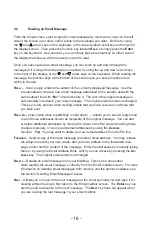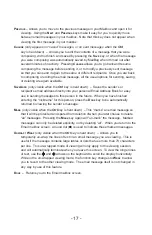
- 26 -
- 15 -
Why printing to a fax machine is a better solution than a computer-printer
Fax machines are as inexpensive today as computer printers, but they are easier and
cheaper to operate than computer printers. In addition, MailBug doesn’t have a printer
port – there’s nowhere to plug in a computer printer. More important, MailBug customers
typically keep their MailBug in the kitchen or some other location where they have easy and
quick access to it, and no one wants computer cables and a bulky printer cluttering up their
kitchen counter. Because MailBug does not need to be directly cabled to the fax machine,
you can keep your MailBug in the kitchen and install your fax in your home office or another
room where it’s out of the way. MailBug can send your email to any fax destination. Send
your email to your own fax machine to print it in the other room. Or, send it to the office fax
to be printed there. Or, just use MailBug to compose and send quick and easy faxes of any
sort to the office, or to a company, or to the kids, or to anywhere else.
Printing to a fax is inexpensive
As part of your MailBug email service, you can send five pages FREE each month to
any fax number in the US or Canada. If you wish to send additional fax pages, contact
Landel Customer Service. Keep in mind that short emails are generally a single page, and
longer emails may require several pages.
Sending email from MailBug to your own fax machine
To print an email from your MailBug to your fax, just use your MailBug to send the email
to your own fax number using the special email address below. You can compose and
send a new email message to your fax, or forward a sent or received email to your fax.
This only works from your MailBug – sending an email to this special address from a
computer will not work.
Using MailBug to send a fax to someone else’s fax machine
You can also use your MailBug to send an email to a fax machine at another location.
You can send it to the office, or to a friend’s house, or anywhere else in the US or Canada.
In this sense, your MailBug has become a fax. Not only can it print email on your own fax,
you can use MailBug as a mini-fax machine whenever you need one. If you need to fax
something to someone, you can just type an email as you normally do right on your
MailBug and send it as a fax using the special address below.
Similarly, outgoing email messages that you have sent (but that have not yet been
delivered) are also shown on this list marked with a diamond (
) next to the
To:
label.
Once these outgoing messages have been sent, the diamonds will disappear.
If a large dot (
) appears after the
To:
or the
From:
on any line, it means that that email
message is “marked” and is protected from deletion if you attempt to delete “all” emails
in the list.
If a function key label on any of MailBug’s screens starts with a diamond (
), then pressing
the
Enter
key on the keyboard has the same effect as pressing that function key. For the
Email screen, this diamond is before the
r
eaD
key, meaning that you can open and read
the email that the cursor is pointing to by simply pressing the
Enter
key on the keyboard.
The upper right corner of the Email screen shows the current date and time, which is
automatically set whenever you connect to the network to send or check for email.
Along the bottom of the Email screen are the different functions, or actions, that you can
choose. The functions listed below are described in greater detail later in this manual.
c
ompoSe
compose a new email message
r
eaD
open and read the email message pointed to by the cursor
D
elete
delete the email message pointed to by the cursor
a
DDreSS
open your personal email address book and make changes
D
oNe
returns you to the idle screen
The following functions appear only when the
Ctrl
key is held down:
S
etup
enter the Setup screen – see Section 3.3 for more details
m
ark
“marks” an email message so that it will be spared when deleting
“all” messages. Pressing this key again will “un-mark” the message
S
ave
a
DDr
saves the sender’s or recipient’s address in your personal email
address book
















































